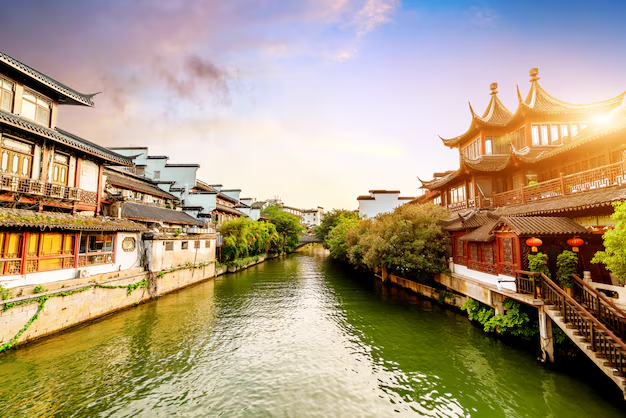Nanjing, one of China’s ancient capitals, is a city steeped in history and culture. Among its many treasures, the Nanjing Confucius Temple (also known as Nanjing Fuzimiao) stands out as a must-visit destination for travelers seeking a blend of historical significance, architectural beauty, and vibrant local life. Located along the scenic Qinhuai River, this iconic site offers a window into China’s Confucian heritage and a taste of Nanjing’s unique charm. Here’s a detailed guide to help you plan your visit.








A Travel Guide to Nanjing Confucius Temple
Overview
The Nanjing Confucius Temple was originally built in 1034 during the Song Dynasty to honor Confucius, the revered Chinese philosopher whose teachings shaped education, ethics, and governance in China for centuries. While the temple has been destroyed and rebuilt multiple times due to wars and natural disasters—most notably during the Second Sino-Japanese War—the current structure largely dates back to the Qing Dynasty with modern restorations. Today, it serves as both a historical landmark and a bustling cultural hub.
The temple complex is situated in the heart of Nanjing’s old city, near the Qinhuai River, and is surrounded by traditional streets, shops, and eateries. It’s not just a place of reverence but also a lively area where history meets modernity.
How to Get There
By Air: If you’re traveling from outside Nanjing, fly into Nanjing Lukou International Airport (NKG), about 40 kilometers from the city center. From there, take a taxi, airport shuttle, or the metro (Line S1) to downtown Nanjing.
By Train: Nanjing is well-connected by high-speed rail. Nanjing South Railway Station is a major hub. From there, take Metro Line 1 to Sanshanjie Station, a short walk from the temple.
By Metro: The most convenient way to reach the temple is via Nanjing’s metro system. Get off at Sanshanjie Station (Line 1) or Fuzimiao Station (Line 3). Both are within a 5-10 minute walk.
By Foot: If you’re staying in central Nanjing, the temple is easily walkable from many nearby hotels or attractions like Zhonghua Gate.
What to See and Do
The Confucius Temple Itself
The main hall, Dacheng Hall, is the centerpiece of the complex, featuring a statue of Confucius and intricate wooden architecture. Take time to admire the traditional Chinese design elements, such as upturned eaves and detailed carvings.
Explore the smaller exhibition halls, which display artifacts related to Confucian philosophy, ancient education, and the history of the temple.
Qinhuai River Scenic Area
The temple sits along the Qinhuai River, often called the “mother river” of Nanjing. Stroll along the riverbanks or take a boat ride (available day or night) to enjoy picturesque views of traditional buildings, arched bridges, and lanterns reflecting on the water.
Nighttime boat rides are especially popular, as the area lights up with colorful lanterns, creating a magical atmosphere.
Shopping and Souvenirs
The surrounding pedestrian streets are lined with shops selling local handicrafts, silk, jade, and Nanjing specialties like yuhua tea and salted duck-themed souvenirs. Bargaining is common, so don’t hesitate to negotiate prices.
Look for traditional calligraphy brushes or Confucian-inspired artworks as unique keepsakes.
Cultural Performances
Occasionally, the temple hosts cultural events, such as traditional music performances or reenactments of ancient Confucian ceremonies. Check with local tourism boards or your hotel for schedules.
Nearby Attractions
Zhan Garden: A short walk away, this classical Chinese garden offers serene landscapes and a peaceful escape from the bustling temple area.
Laomendong Historical Area: Another nearby spot, this restored neighborhood features old-style architecture, tea houses, and a glimpse into Nanjing’s past.
Where to Eat
The Nanjing Confucius Temple area is a food lover’s paradise, especially for those eager to try local Jiangsu cuisine. Here are some recommendations:
Nanjing Duck Dishes: Try salted duck (yánshuǐ yā) or duck blood vermicelli soup (yā xuè fěnsī tāng) at street vendors or small eateries.
Qinhuai Snacks: Head to the Qinhuai Snack Street near the temple for classics like tangbao (soup dumplings), sesame pancakes, and sweet osmanthus sticky rice.
Restaurants: For a sit-down meal, establishments like “Jinling Chun” offer refined versions of Nanjing specialties in a traditional setting.
Best Time to Visit
Spring (March-May): Mild weather and blooming flowers make this an ideal season, though it can get crowded during holidays like Qingming Festival.
Autumn (September-November): Cool temperatures and clear skies enhance the experience, especially for outdoor activities like boat rides.
Nighttime: Regardless of season, visiting in the evening is highly recommended for the illuminated scenery and cooler atmosphere.
Avoid peak holiday periods like Chinese New Year or National Day (early October) if you prefer fewer crowds.
Practical Tips
Entrance Fee: The temple itself has a modest admission fee (around 30-40 RMB), though some areas, like the surrounding streets, are free to explore.
Language: English signage is limited, so consider downloading a translation app like Google Translate or bringing a phrasebook.
Dress: Wear comfortable shoes for walking, and dress respectfully if entering the temple (avoid overly casual attire like shorts or tank tops).
Cash: While digital payments (WeChat, Alipay) are widely accepted, carry some cash for small vendors.
Crowds: The area can get busy, especially on weekends. Arrive early or visit on a weekday for a quieter experience.
Why Visit?
The Nanjing Confucius Temple is more than just a historical site—it’s a living piece of Nanjing’s identity. Whether you’re drawn by its philosophical significance, the beauty of the Qinhuai River, or the chance to savor local flavors, this destination offers something for every traveler. It’s a perfect blend of education, relaxation, and exploration, making it an unforgettable stop on your journey through China.
Plan your trip, soak in the atmosphere, and let the spirit of Confucius guide your adventure in Nanjing!













